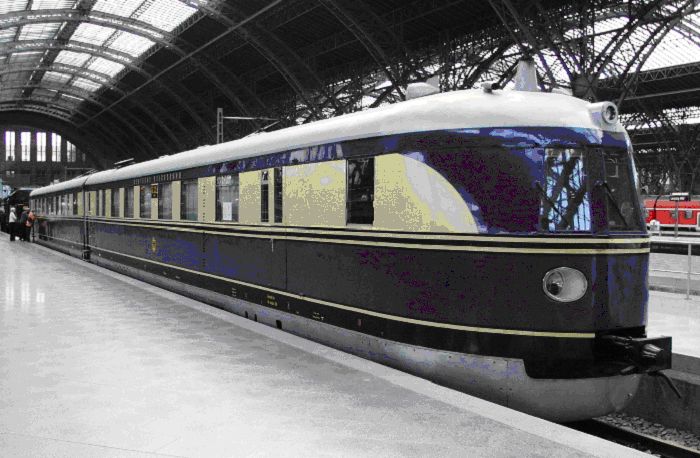

Founded 1953
Flying Hamburger (Fliegender Hamburger )
In the period starting in 1933 the German flying hamburger was running the fastest timetabled service in the world.
A 2-car diesel train covered the 178 miles from Berlin to Hamburg at an average speed of 77.4 mph.
The Hamburg Flyer, a deisel train consisting of two cars – each having a driver's cab and passenger cabin – was ordered by the Deutsche Reichsbahn-Gesellschaft in 1932 from Waggon- and Maschinenbau AG Görlitz (WUMAG). The train was delivered in 1932 and put into service in 1933.
The train was streamlined after wind tunnel experiments, a sort of research which was pioneered by the developers of the high-speed interurban railcar Bullet a couple of years before. The Fliegender Hamburger design lightweight design, articulated construction and Jakobs bogies were also known on the US interurban scene. However, the Fliegender Hamburger had diesel-electric propulsion. Each of the two coaches had a 12-cylinder Maybach diesel engine with a direct current generator directly coupled to it, which drove a Tatzlager-traction motor. The two engines developed a combined power of 604 kW.
The train had a pneumatic brake developed by Knorr and an electromagnetic rail brake. At 160 kilometres per hour (99 mph), it needed 800 metres (2,600 ft) to come to a halt.
The train had 98 seats in two saloon coaches and a four-seat buffet. The Hamburg Flyer was the prototype for the later trains of the DRG Class SVT 137, which were called Hamburg, Leipzig, Köln and Berlin.
As a sign of its exclusivity, the Hamburg Flyer was painted cream and violet – like the coaches of the Rheingold Express train.
